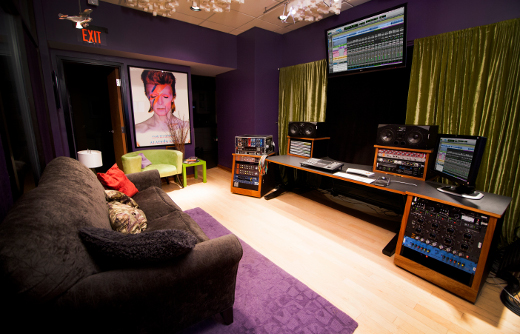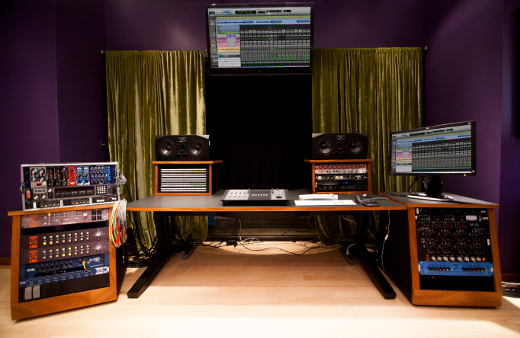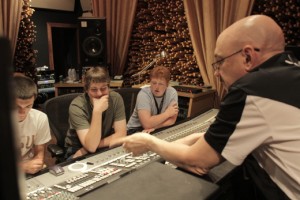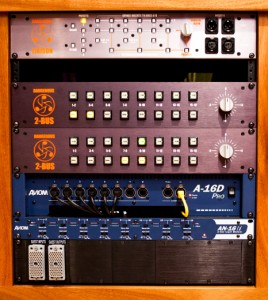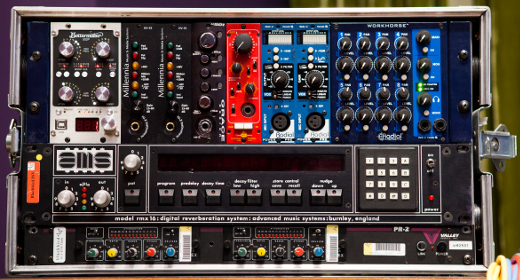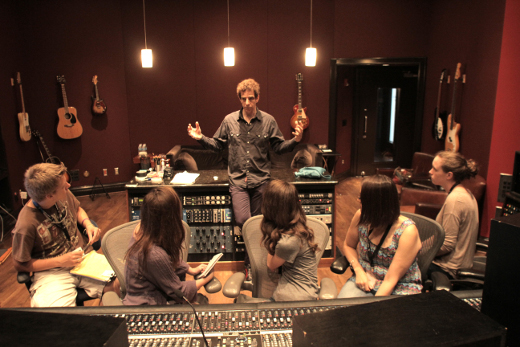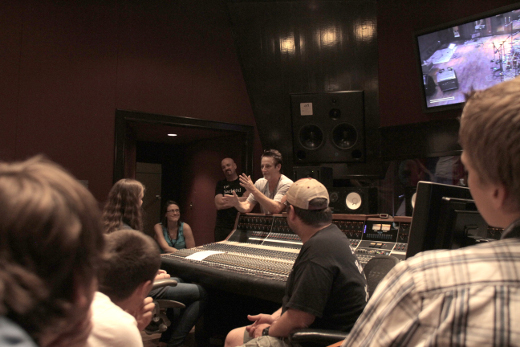Nouveau Signal Flow: The New Studio I at The Blackbird Academy
Studio engineers in search of fresh ideas for signal flow: Ready to get an education?
Then go inside the intriguing design of the freshly minted Studio I at The Blackbird Academy in Nashville, which was designed from inception by its dedicated audio educators to do what no other teaching facility can do. In the process, Blackbirds principals John McBride, Kevin Becka, and Mark Rubel built an incredibly flexible new room that not only other schools can learn from, but also any studio that wants to dramatically renovate its workflow.
Launched in 2013 to provide students with an experience-based education within one of the world’s most in-demand sound facilities — McBride’s famed Blackbird Studio – the academy’s curriculum is taught by an all-star team of “musical mentors”. In addition to the expert staff, visiting mentors so far have included Dave Stewart (The Eurythmics), Ken Scott (engineer/producer), Ben Wysocki (The Fray), Tim McGraw, Bob Olhsson (engineer), Nick Raskulinecz (engineer/producer), Viktor Krauss (bassist), Dave Morgan (live sound engineer), Julia Sheer (artist), Dave Pensado and Herb Trawick.
When Becka, a veteran engineer and elite pro audio journalist (Mix, Pro Audio Review, Audio Media) got the rare opportunity to design a new studio from scratch – well, let’s just say you didn’t have to twist his arm.
At The Blackbird Academy, you’ve had the rare opportunity to start an audio education program from the ground up. What’s that experience been like so far?
We’re on a rocket ship. When I first started meeting with John (McBride) and Mark (Rubel), we had these intense brain storming sessions and it got very exciting. We quickly realized that because of the foundation that Blackbird Studio offered, plus our individual talents, we could offer something unique.
Students have access to incredible facilities, ideas, world class instruction and guest lecturers, all styled in a mentor-based curriculum that is literally changing their lives. I really mean that – we’ve seen incredible progress in just the first 10 weeks of the program.
What are some examples of that?
For example, in week 4, the students spent a week tracking and mixing a band, then in week 7, they spent 3 days with producer/engineer Nick Raskulinecz who worked with them specifically on tracking drums in Studio A. We did 10 setups and teardowns on a drum kit with different mics and placement techniques in two days. It was a mind blower.
The following week, recording artist Julia Sheer came in and we tracked and mixed a great band in studios D and C, all filmed for an upcoming YouTube reality show debuting in February. The students nailed the drum setup and sounds. I remember going out to the room to fine-tune the placement, and it was spot on. Students took the knowledge they got from Nick and used it on another project with perfect execution. It was a lightbulb moment.
It’s one thing to think of something in an idea session with the founders, but once you see how fast students are learning, and how the industry, and even other established colleges want to be part of what we’re offering, it’s really quite something. People are getting what we’re doing, which is great.
As the school has gone from a concept to reality, how has that affected your awareness of what the school needs in terms of facilities, and the gear that you equip it with?
It was great to start the school on the foundation of Blackbird Studio. In my years as an audio journalist and product reviewer, I’ve seen many facilities worldwide. Judged just by how busy it is, Blackbird is inarguably one of the top 5 recording studios in the world.
Then when you get to the mics, instruments, rooms, consoles, OB gear and staff, it jumps to the top of the list. I’m not exaggerating. So this was our base.
Once we established the curriculum and how it would flow into the existing facility, we moved on to designing the classroom and Studio I, both completely new builds and concepts.
The classroom is literally a working studio with two iso booths, an API 1608 console, patchbay, Dynaudio mains, Emotiva minis, OB racks, Pro Tools HDX, Logic 10 and seats for 30 students. Each student station is tied to the main patchbay so we can send eight channels to each station and get two back. This allows the instructor, and all the students to record simultaneously.
Then the instructor can patch mixes back from each station for playback onto the main system. The student rigs each have a Universal Audio Apollo interface with every UAD-2 plugin, Pro Tools, Logic, Shure headphones and more.
The desks were designed by Setco, a company that does a lot of custom builds for touring here in TN. Then we were fortunate enough to interest NY designers Bob and Cortney Novogratz in our project who came down and knocked the finish of the room out of the park. We were featured on the Katy Couric show twice last year.
Both the tech and trim makes for a great way to teach in a great-looking studio environment. Each student can swap live audio with the teacher and trade audio files with each other across a network – everything works together.
On the visual side, Blackbird IT guru Nick Shasserre has pan/zoom/tilt cameras placed in the isos, above the console and the back of the room which we can push to our three 65” flat screens. It’s very immersive.
Tell us about the design concept behind Studio I — what are the unique needs of a studio designed specifically for audio education?
Studio I was a pet project of mine. I wanted to build something that was very different from a traditional studio, which we already had nailed.
To get the students up to speed with modern production, they should be exposed to every kind of working environment, especially desktop. So with John’s blessing I put together a summing-based, desktop production room that can jump from tracking, to mixing, to mastering.
In my career, I’ve been fortunate to have built two studios where I literally worked construction – bricks and mortar – to a home studio for Kenny G, to the Esquire House in 2010 where we put a high end tracking room into a house in the hills above LA. In 2011 I built my own space at home which is more like Studio I, except scaled down.
With Studio I, we had a chance to take the idea to the nth degree by using Blackbird rental gear as the front and back end, and integrating it through Dangerous Music’s summing, monitoring and processing gear recording to Avid’s latest for Pro Tools. The room was a former lounge with a large, glass front window that looked down into the tracking space – beautiful.
Please tell me about the signal path that you designed – how are the equipment choices fitting in with your academic plan?
For starters, the summing concept is elegantly played out with the Dangerous 2 Bus. It’s a hands-off approach that adds no color to the signal and lets us hear all the great Blackbird mics and gear just as they sound. That was very important.
Next, the Dangerous Liaison lets us A/B compare processors in a quick fashion. We place much emphasis on listening skills at The Blackbird Academy – starting each day with an “Ears On” session. So being able to compare gear through quick relay switching with memory is fantastic.
The Dangerous Monitor ST is a great way for us to hear exactly what we’re getting out of our converters, processors and summing system. Once again, it’s relay switched and clean. Plus it’s future proof. Although we didn’t start this way, the room is large enough to support a surround setup. With the Monitor ST, we can easily step up to that workflow – we won’t have to gut and re-invent the room to jump into a multi-channel setup.
Lastly, the BAX EQ is a versatile tool that can be used when mixing and tracking. I’ve used it across my overheads when going to Pro Tools HD during a tracking session, then turned around and patched it on my 2 bus when mixing. It’s subtle, clean, and lets us demonstrate the power of filtering out the extremes of the spectrum to increase our headroom.
Besides the Dangerous gear, what are some other choice pieces of hardware and/or software that you specified for the room, and why?
We’ve got 32 channels of Pro Tools HDX with the new IOs from Avid which sound great. Preamps are a revolving cast from rentals but now include units from GML, Shadow Hills, John Hardy, Millennia Media, Grace Design, Chandler Ltd., and Radial Engineering. The outboard racks include something old and something new including an AMS RMX16 reverb, NTI EQ3, Bettermaker EQ502P, Empirical Labs FATSO JR, Alan Smart compressor, ATI mixer for talkback from the floor and gates from Keepex.
In the computer we have a UAD-2 Quad card and all the UAD-2 plugs plus the usual cast of plugin characters from the rest of the industry. We’re listening on ADAM S3-A monitors and are using an Aviom A16-D Pro headphone system when we track and overdub.
That’s an intensive setup! So what has been the faculty and student response been to the room so far? Are you finding that it is enabling you to do things beyond what you had planned on when you designed it?
We’ve had a range of sessions in I and it’s been a blast. The students are grouped in workflows of five each per class so there is a lot of focus with their hands on the gear, and they can book the room for projects.
As with the rest of the program, we’ve written interactive books for the patchbay and another for room operations so you can hold the Rosetta stone in your hand on the iPad and work through all the gear until the ideas and workflow is solid.
It’s a great way to learn! Concepts first, then soon after, execute over and over. That’s what we’re all about here.
— David Weiss
Please note: When you buy products through links on this page, we may earn an affiliate commission.







